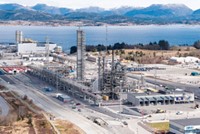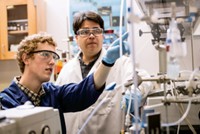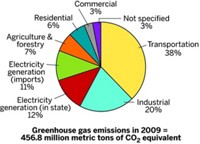Advertisement
Grab your lab coat. Let's get started
Welcome!
Welcome!
Create an account below to get 6 C&EN articles per month, receive newsletters and more - all free.
It seems this is your first time logging in online. Please enter the following information to continue.
As an ACS member you automatically get access to this site. All we need is few more details to create your reading experience.
Not you? Sign in with a different account.
Not you? Sign in with a different account.
ERROR 1
ERROR 1
ERROR 2
ERROR 2
ERROR 2
ERROR 2
ERROR 2
Password and Confirm password must match.
If you have an ACS member number, please enter it here so we can link this account to your membership. (optional)
ERROR 2
ACS values your privacy. By submitting your information, you are gaining access to C&EN and subscribing to our weekly newsletter. We use the information you provide to make your reading experience better, and we will never sell your data to third party members.
Environment
Ending Plants' Wasting Ways
Small DOE industrial energy auditing program shows big energy efficiency, financial gains
by Jeff Johnson
January 14, 2008
| A version of this story appeared in
Volume 86, Issue 2

FREDERICK FENDT DIDN'T EXPECT too much from a Department of Energy-led, three-day energy audit of Rohm and Haas's Deer Park, Texas, chemical plant. After all, Rohm and Haas has had its own on-site energy team working at the plant for 10 years, and Fendt himself monitors energy use there as a corporate-wide energy and pollution abatement systems engineer.
What's more, the Deer Park plant is huge. How much could be accomplished in a three-day energy audit?
Despite the odds against much success, there was good reason to give it try. The 800-acre chemical plant consumes 40% of all energy used by Rohm and Haas's 120 plants around the world, and it's the world's largest manufacturer of methacrylic and acrylic monomers, Fendt says. So when Paul Scheihing, who manages the DOE Industrial Technologies Program and coordinates the audits, urged Fendt to take part in a free energy assessment, he agreed.
"Energy has always been very important to us in this plant, so we worked together with the DOE auditor on a steam-use assessment," Fendt says, "and what we found was astounding. Ten years of looking at this plant—we'd never seen this situation."
Like all chemical plants, the facility uses large amounts of steam. The DOE audit focused on steam generation and use as well as natural gas consumption. The facility's primary boilers produce steam at a pressure of 600 psi, and the pressure is dropped for various applications in an integrated system that depends on plant needs. The audit found that many low-pressure applications were using steam reduced from the 600-psi system instead of utilizing lower pressure steam that was being wasted.
"The audit turned out to be a big deal," Fendt says. Apparently, changes in steam usage had crept up over the years, unnoticed. The efficiency modifications cost only a few thousand dollars for repiping and rebalancing the steam system; the changes paid for themselves in days, he says.
A similar DOE audit was conducted at another Rohm and Haas-owned facility: Morton Salt in Grand Saline, Texas. There, Fendt says, auditors found ways to mechanically recompress water vapor that was being used to drive water evaporation from salt brine. The modification saved energy by reducing the steam demand from the salt plant's primary boiler.
Rohm and Haas is one of 350 companies that have benefited from the DOE "Save Energy Now" assessments. The program began in late 2005, specifically looking at ways to reduce industrial consumption of natural gas, Scheihing explains.
Scheihing estimates the program has made recommendations that have saved companies more than $95 million per year and has identified measures companies are now adopting that will save three times that much. He says the potential annual natural gas savings amount to 66 trillion Btu of natural gas—the equivalent of the carrying capacity of 21 liquid natural gas tankers. And these money and energy savings ought to only grow this year, he says, as the program conducts what it hopes will be another 250 assessments.
"This is one of the most successful federal energy-efficiency programs of all time," says R. Neal Elliott, industrial program director with the American Council for an Energy-Efficient Economy. "Companies want to pick the low-hanging fruit and save money through efficiency," he says, "but they've got to know what the low-hanging fruit looks like to pick it.
"This is what the program is—a crash course in educating manufacturing managers across the country in what this fruit looks like," Elliott points out.
Save Energy Now has certified about 80 engineers to conduct these energy assessments, a number that has grown from 35 in 2006. Scheihing estimates each assessment, which is free to the company, costs DOE about $8,000. The assessment program draws about $3 million of the overall $45 million budget for DOE's Industrial Technologies program, which supports industrial energy-efficiency R&D and plant-specific efforts to encourage greater efficiency by U.S. industry.
ABOUT HALF of the world's energy is consumed by manufacturing, Scheihing says. U.S. companies use about one-third of the nation's total energy and about 35% of its natural gas, according to DOE Energy Information Administration figures. Despite the significance of industrial energy, funding for the DOE industrial-efficiency program has been sliding downward. In 1998, the Industrial Technologies Program received $200 million. The program is split between research for new technologies and technical assistance, like the audit program.
Although Elliott applauds the energy- efficiency outreach and education part, he worries about declining funding for the overall program, particularly cuts to the sort of research that in the past has led to the introduction of new energy-efficient manufacturing technologies. Without this research support, he predicts, development of new and potentially more far-reaching industrial energy-efficiency processes will stall in the years ahead.
Looking at the technical assistance side, the assessment program's focus is on large companies. Overall, DOE estimates that there are about 226,000 manufacturing plants in the U.S. About 6,800 of these plants are large and have energy costs exceeding $2 million per year and natural gas consumption of at least 1 trillion Btu annually. These 6,800 facilities consume about 53% of all energy used by U.S. industries and are the primary concern of the Save Energy Now assessments.
Here's how the program works: On the first and second days of the assessment, DOE assessors join a small internal team at the plant and use energy-efficiency computer software developed by DOE to determine where in the plant energy savings are most likely.
"The neat thing is that assessors spend a lot of time training the team on how to use the DOE tool," Scheihing says. "The assessment is really a training device in which the internal team gets familiar with the DOE software through real applications at their plant."
On the third and final day, the assessors and the team present their findings to the plant's upper management. Often, Scheihing continues, the assessors find that plant engineers have already identified some of the potential energy savings but were unable to convince upper management to make the changes.
"Sometimes the recommendations of outside experts help get these decisions made," he notes.
The program has expanded beyond natural gas and steam and is now looking at energy-efficiency potential for compressed air, pump, and fan systems, Scheihing says. DOE conducts follow-up surveys at six-, 12-, and 24-month intervals after the assessment. Based on these surveys, Scheihing estimates about 70% of companies are planning to implement recommended actions that emerged during the assessment.
The companies are expected to produce internal and public reports on the audit results, and DOE includes these results with its database of industrial efficiency information that, along with software-auditing tools, is offered to companies doing their own assessments.
Indeed, Scheihing stresses that DOE is only able to assess a small proportion of the nation's plants, and there are also clear limits on what can be accomplished in a three-day audit. Hence his hope is that smaller companies will use DOE's database and that large ones will incorporate the department's "best practices" software and efficiency tools into their own energy-analysis systems and apply them at all plants throughout their corporate structure.
At Rohm and Haas, Fendt notes that he has worked for the company for 20 years and still hasn't been to half its smaller plants.
"We need efficiency assessment tools we can put out to the plants to use. We could develop them ourselves-we know how to do it-but it is too expensive and we don't have the time," Fendt explains. The best practices software, he says, "draws a map for engineers showing them where the big efficiency hitters are, where they can save the most money, and where to look first."
But for Rohm and Haas's biggest plant at Deer Park, the assessment results shows the importance of fresh eyes, Fendt says.
"Next year, we are bringing in outside consultants, and we are going to go over the plant from stem to stern," Fendt says. "I am just convinced that there is other stuff we have missed after having seen this assessment. We'll take six months and go through the whole plant."
FOR THE FUTURE, Fendt and Scheihing are working on a certification program that will use third-party auditors to document energy-efficiency savings. Scheihing notes that energy-efficiency improvements reduce carbon dioxide emissions and may prove to be valuable financial assets if Congress and President George W. Bush back legislation to institute a cap on CO2 emissions and a carbon-trading program.
"Lots of companies are now working on energy-efficiency projects to reduce emissions and save money," Fendt says. "At some point, CO2 reductions are going to be required. A number of us in industry are saying that we need some sort of mechanism to certify the efficiency gains we make so we can use them for CO2 credits. This may not be DOE's purpose in the energy program, but industry wants to make sure those of us who are doing the right thing can document what we did and get credit for it," he explains.
Scheihing is also trying to extend the audit program to state energy departments and encourage them to pick up the program. Last year, DOE issued about $1 million in grants to 19 states to conduct their own plant-efficiency audits. In Wisconsin, DOE signed a deal to work with the state to train 20 assessors and conduct 200 assessments over the next three years.
On the agenda for these assessors will be a half-dozen ethanol plants, which are among the fastest growing users of natural gas in the nation. The goal at these venues will be to make those who are trying to help the U.S. kick the petroleum habit do so in as energy efficient a manner as possible.







Join the conversation
Contact the reporter
Submit a Letter to the Editor for publication
Engage with us on Twitter